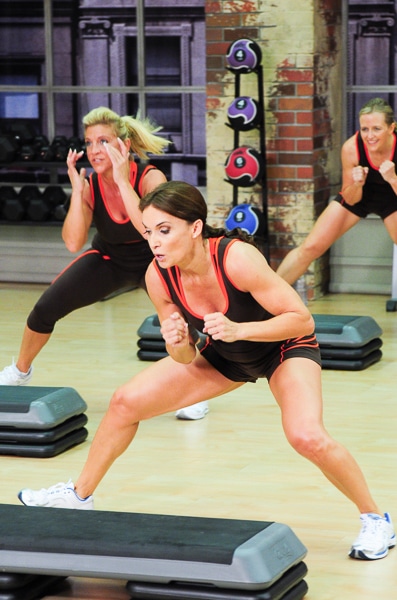 At one time, fitness buffs thought they had to spend an hour working out – or at least 30 minutes. After all, most experts believed that 30 minutes of exercise a day was the minimum you needed to get real benefits – but recently workouts have grown shorter. How short? Twenty minutes or less. Now some fitness gurus are saying very short workouts of ten minutes or less work best. It certainly sounds appealing. Ten minutes of sweating and you’re done for the day – but will you get results?
At one time, fitness buffs thought they had to spend an hour working out – or at least 30 minutes. After all, most experts believed that 30 minutes of exercise a day was the minimum you needed to get real benefits – but recently workouts have grown shorter. How short? Twenty minutes or less. Now some fitness gurus are saying very short workouts of ten minutes or less work best. It certainly sounds appealing. Ten minutes of sweating and you’re done for the day – but will you get results?
Are Short Workouts Effective?
From a cardiovascular standpoint, very short workouts have benefits. For example, one study showed a daily Tabata protocol increased aerobic capacity to a greater degree than an hour of steady-state cardiovascular exercise on an exercise bike. Plus, it increased the anaerobic capacity of the participants while steady-state cardio didn’t.
How short is a Tabata protocol? It basically consists of a 5-minute warm-up, 8 intervals of all-out cardio for 20 seconds separated by 10 seconds of rest between each interval, and a 2-minute cool-down. That’s a total of 11 minutes. Who wouldn’t want to do an 11-minute workout and call it quits for the day?
There’s no doubt that ultra-short, intense routines Tabata-style work, but they aren’t necessarily a substitute for longer workouts. The Tabata study showed the increase in aerobic capacity (V02 max) leveled off after a few weeks and the participants didn’t make further gains in V02 max, even though their anaerobic capacity continued to improve for several more weeks.
Yes, you can get cardiovascular benefits from brief exercise, but you have to push yourself maximally during the work intervals to get them. What short workouts lack in length, you have to compensate for with intensity. Even so, there seems to be a plateau effect with very short exercise routines of 15 minutes or less where you don’t continue to see improvements in V02 max after a few weeks.
Other Limitations of Very Short Workouts
Brief, intense workouts of 15 minutes increase V02 max and anaerobic capacity but aren’t ideal for building endurance. You need long stretches of exercise to build stamina and endurance, so your body can make adaptations that allow you to do sustained exercise with less effort. Short, intense workouts are best for training your body to handle short, intense exercise, not long stretches of cardiovascular exercise. An endurance athlete probably won’t tolerate a high-intensity Tabata routine well unless they’d trained. At the same time, a Tabata-trained athlete won’t have an impressive marathon time, if they complete the marathon at all. There is some degree of training specificity at work here as well.
Then there’s the issue of balanced workouts. You can do a short circuit workout alternating cardio with resistance exercises when you’re pressed for time, but you won’t have enough minutes to work on flexibility and balance. These are also important for overall fitness. Plus, very short workouts aren’t ideal for building strength and lean body mass since you’re not doing more than one set and you’re not working to near-failure.
Brief Workouts Have Their Place
Workouts under 15 minutes have benefits as long as you push hard every second during the active intervals, but they work best when they’re part of a more balanced fitness program. On days when you’re pressed for time and need to fit in a quick workout, it’s nice to know short workouts work, but if you do them exclusively, you’ll likely reach a plateau.
Overall, you’ll get better results if you vary the length of your workouts and the type of stress you put your body under. If you’re trying to build lean body mass, you’ll need longer resistance-training sessions where you do more than one set to get the most results, and if you’re trying to lose body fat, a longer cardio session at least once a week helps with fat-burning. Another possibility is to do several, short workout sessions interspersed over the day like my Tabatacise DVD that has five Tabata workouts.
The Bottom Line?
There’s no reason not to do an occasional brief workout. Pushing yourself very hard for short periods of time is the best way to boost your anaerobic capacity – but don’t restrict yourself to very short workouts exclusively. Intersperse them with longer sessions of cardio, strength and cardio-strength circuits – and don’t forget to add some flexibility and balance training to get a completely conditioned body. It’s nice to have a little variety, and it helps you stay motivated too.
References:
Med Sci Sports Exerc 28 (10): 1327–30. doi:10.1097/00005768-199610000-00018.
On Fitness magazine. March/April 2013. Pages 73-74.
Related Cathe Articles:
Don’t Be Afraid to Split Up Your Exercise Sessions
For More Effective Workouts, Science Says You Need Exercise Variety
Tabata Workouts: Will the Real Tabata Please Stand Up?

